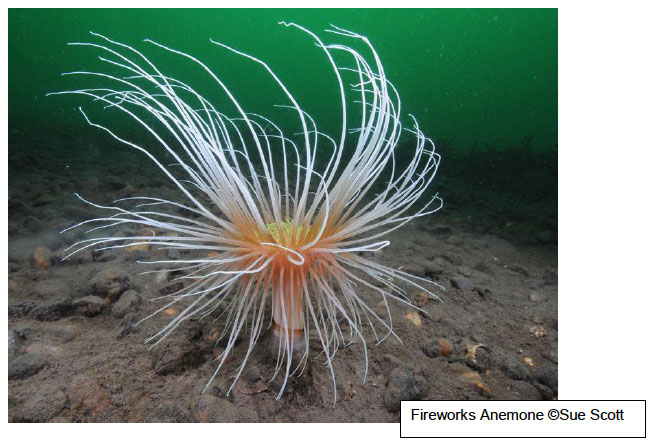Report to the Scottish Parliament on Progress to Identify a Scottish Network of Marine Protected Areas
This reports on which sites are currently included in the MPA network and outlines progress on Nature Conservation MPAs, Historic MPAs, and Demonstration and Research MPAs.
Why do we need Marine Protected Areas?
Scotland's seas support a huge diversity of marine life and habitats, with around 6,500 species of plants and animals, with plenty more no doubt to be found in the undiscovered deeps of the north and west of Scotland. These include species such as:
- Deeper water habitats comprising species such as cold water corals, sea fan communities. Off the Sound of Canna can be found the largest aggregation of fan mussels in UK waters and one of the deepest and most unusual examples of a horse mussel bed;
- 24 species of seabird living in breeding colonies around the Scottish coast;
- Sharks, rays and skates, including the world's second-largest fish, the basking shark, which can reach 8m long;
- In the past 25 years,23 species of whales, dolphins and porpoises have been spotted around the Scottish coastline, of which 8, including minke and killer whale, are permanent residents;
- Many seals are also residents here, such as harbour and grey seals, and they spend most of their time at sea, sometimes coming ashore to breed, moult or simply to languish on rocks after a hard week's fishing;
- And, in proportion to its size, Scotland is the Earth's most geologically diverse country. Almost every period of geological time is captured in the rock record, and many of these can be found in our coastal waters.
The seas around Scotland are among the richest in Europe for marine mammals. Scotland holds about 70% of Europe's population of grey seals, over 100,000 individuals, and over20,000 common seals or 35% of the EC population, emphasising the important role that seals have in Scottish waters. 14 SACs have so far been designated for grey and common seals.
Scotland is home to the most northerly pod of bottlenose dolphins which are found within the Moray Firth, which was designated an SAC in March 2005. These are larger and more blubbery than tropical bottlenose dolphins to survive the bitter cold of the North Sea, and the Moray Firth is one of only 3 SACs found in the UK for bottlenose dolphins.
Loch Creran is the only SAC in Europe designated to protect the delicate and colourful serpulid reefs built by the tube worm s erpula vermicularis, and this is the largest discovery of this habitat in the world. And a recent survey in Loch Alsh commissioned by Marine Scotland in August 2012 for the identification of MPAs found what appear to be the most extensive and best developed flame shell beds in the UK.
Scotland's seas are also home to 45% of Europe's breeding seabirds with internationally important numbers of 24 breeding species. We have SPAs for the protection of seabird species, such as the great skua, of which more than half of the world's population return to Scotland each year to nest. With approximately 5 million seabirds in Scotland, all foraging in our seas, there is approximately one seabird per person in Scotland!
Our seas account for 61% of UK waters and remain at the forefront of our food and energy needs, through fishing, aquaculture, oil and gas, and new industries such as renewables, as well as recreation activities and eco-tourism.
We already have a network that includes existing protected areas for many of these species and habitats such as Special Protection Areas ( SPAs) for almost every specie of seabird found in our seas and coastlines. Special Areas of Conservation ( SACs) offer further spatial protection for features like bottlenose dolphin, coral reefs and seals. These protected areas are ones we are required by law to designate under European Union Directives.
However we do not believe we have enough protection in the marine environment from these marine protected areas to properly protect all the pieces of the complex marine ecosystem. We decided, with the aid of the Marine (Scotland) Act, to offer conservation measures to those features that needed protection through the designation of new MPAs. And these MPAs are for features which are considered by the country's leading marine scientists and international studies to most deserve our protection, either because they are rare, threatened or declining, representative or because they are almost only found here.
An ecologically coherent network of well-managed marine protected areas is therefore vital to conserve and regenerate our seas, in turn protecting the many goods and services they provide now, and for generations to come.
Scotland's coasts and seas also preserve a rich cultural heritage dating from early prehistory to the recent past including remains of coastal settlement (submerged landscapes) and thousands of wrecks of ships and aircraft. The marine cultural heritage helps us to appreciate the importance of our coasts and seas throughout Scotland's history, contributes to our sense of place and wellbeing, enhances the distinctiveness of coastal areas and helps attract visitors to Scotland.

Contact
There is a problem
Thanks for your feedback